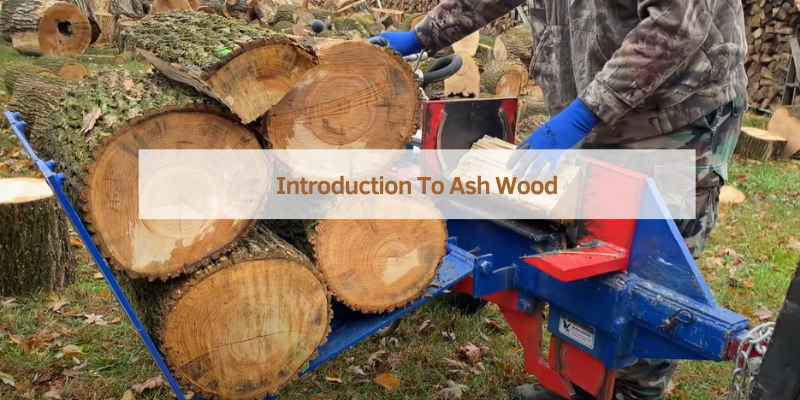Yes, ash wood splits easily. It is known for its straight grain and minimal knots.
Ash wood, a popular choice for firewood, is renowned for its ease of splitting. This hardwood’s straight grain and minimal knots make it an efficient option for those needing to prepare firewood quickly. With its high density and low moisture content, ash burns well and provides consistent heat.
It’s also a preferred material for furniture and woodworking due to its strength and elasticity. Whether for heating or crafting, ash wood offers versatility and reliability, making it a favorite among many users. Its workability ensures that both novice and experienced woodworkers can handle it with ease.
Introduction To Ash Wood
Ash wood is known for its strength. It is also very flexible. Many people use ash wood for furniture. It is also used for making tools. It has a light color. This makes it look nice in homes.
In history, ash wood was used for making weapons. It was also used for building ships. Many old houses have ash wood floors. People trust this wood for many uses. It has been important for a long time.

Characteristics Of Ash Wood
Ash wood has straight grain patterns. These patterns look very neat and clean. The grain is open, which means it has small holes. This makes the wood easy to work with. Ash wood is strong and can handle a lot of weight. It is often used for making furniture.
Ash wood can be light brown or almost white. The color can change as the wood gets older. Some pieces may have darker streaks. These streaks add character to the wood. Ash wood looks very pretty when polished. It can fit in many types of home decor.
Splitting Tendencies Of Wood Types
Ash wood splits with moderate difficulty due to its dense grain structure. Ideal for firewood, it dries quickly and burns efficiently.
Factors Affecting Wood Split
Moisture content plays a big role in splitting wood. Dry wood splits easier than wet wood. Grain patterns also matter. Straight grain wood is easier to split. Wood density affects splitting too. Denser wood can be tougher to split. Tools used for splitting are also important. Using the right tools makes the job easier. Some wood types have natural resistance to splitting. These woods can be more challenging.
Comparative Analysis With Other Woods
| Wood Type | Splitting Ease |
|---|---|
| Ash | Moderate |
| Oak | Hard |
| Pine | Easy |
| Maple | Hard |
Assessing Ash Wood’s Durability
Ash wood is strong and resists decay well. It has a natural ability to fight off rot. This makes ash wood a good choice for many uses. Some woods decay fast, but ash wood lasts longer. It can be used for furniture and tools. People like ash wood because it stays strong.
Ash wood has a long lifespan in different climates. In dry areas, it stays solid for years. In wet areas, it still resists decay well. Ash wood adapts to different weather conditions. This makes it a good choice for many places. Even in harsh climates, it remains durable.
Working With Ash Wood
Ash wood is hard and durable. It is important to use sharp tools. Dull tools can make the job harder. Power tools work well with ash wood. Hand tools can also be used. A good saw and chisel are essential. Sanding may take longer because of its hardness. Always work with the grain to avoid splintering. Proper technique ensures smooth cuts.
Safety is very important when cutting ash wood. Always wear safety goggles and gloves. Ensure your work area is clean and organized. Keep your tools in good condition. Check for knots in the wood before cutting. Knots can make the wood split. Never rush the cutting process. Take your time for accurate cuts.
Split Resistance Of Ash Wood
Ash wood resists splitting due to its dense and straight grain structure. Ideal for furniture and tool handles, it combines durability with a smooth finish.
Impact Of Moisture Content
Ash wood is known for its durability. But its moisture content affects its split resistance. Freshly cut ash wood has high moisture. This makes it easier to split. Dry ash wood is harder to split. The wood becomes tougher as it dries. It’s important to know the moisture level. This helps in splitting wood efficiently.
Seasoning Process
The seasoning process reduces the moisture in ash wood. This process can take several months. Seasoned ash wood is dry and hard. It is less likely to split easily. The wood becomes more stable after seasoning. This makes it ideal for long-term use. Proper seasoning is crucial for ash wood. It enhances the wood’s durability and strength.
Applications Of Ash Wood
Ash wood is popular in furniture making. It is strong and durable. It has a smooth finish and looks beautiful. Craftsmen love its workability. It can be shaped and carved easily. This makes it a top choice for tables and chairs. Ash wood is also resistant to shocks. This quality adds to its popularity in furniture. People enjoy its natural light color too.
Ash wood is used in sports equipment. Its strength is perfect for baseball bats. Players prefer ash bats for their flexibility. It helps in better performance. The wood is also used in making hockey sticks. Its durability stands up to rough play. Ash wood is lightweight yet strong. This makes it ideal for various sports tools.
Preservation And Maintenance
Applying protective treatments is important for ash wood. These treatments help prevent splitting. Use a good wood sealant. This sealant will protect the wood from moisture. Moisture can cause the wood to split. Also, use oils or stains. These products add a layer of protection. They also enhance the wood’s natural beauty.
Regular maintenance keeps ash wood in good condition. Keep the wood clean. Dust and dirt can cause damage. Use a soft cloth to wipe it down. Avoid using harsh chemicals. These can harm the wood. Reapply protective treatments as needed. Inspect the wood for any signs of damage. Fix small issues before they become big problems.
Environmental Impact And Sustainability
Ash trees face threats from diseases and pests. The emerald ash borer is a major pest for ash trees. This pest has caused many ash trees to die. Conservation efforts are important to save ash trees. These efforts include monitoring and managing pests. Also, planting new ash trees helps in conservation. Community involvement plays a big role in these efforts. Schools and local groups can help plant trees. These actions help to preserve the ash tree population.
Sustainable sourcing of ash wood is crucial. It involves responsible tree harvesting. This means only mature trees are cut down. Young trees are left to grow. This practice ensures the forest remains healthy. Certified wood sources follow these practices. Certification labels on wood products indicate sustainable sourcing. Buying certified wood supports eco-friendly practices. Consumers can help by choosing certified products. This way, they promote sustainability and help protect ash trees.

Frequently Asked Questions
How Do You Split Ash Wood?
To split ash wood, use a sharp axe or maul. Position the wood on a sturdy chopping block. Aim for the grain and strike firmly. Ash wood splits best when dry. Safety gear is essential.
What Is The Disadvantage Of Ash Wood?
Ash wood tends to be less durable outdoors. It is prone to moisture damage and insect infestation. This wood also requires regular maintenance to prevent warping and cracking. These factors can increase long-term costs and care requirements.
Is Ash Easier To Split Green Or Dry?
Ash is easier to split when it’s green. Green wood contains more moisture, making it softer and less brittle.
What Wood Is Most Difficult To Split?
Ironwood and elm are the most difficult woods to split. Their dense and interlocking grain patterns make splitting tough.
Conclusion
Ash wood is known for its ease of splitting, making it a preferred choice for firewood. Its straight grain and moderate density contribute to this characteristic. Whether for woodworking or heating, ash wood offers efficiency and reliability. Consider ash wood for your next project or winter preparation.
Its benefits are clear and compelling.


